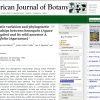
Autores:
Colunga-GarcíaMarín, P.
J. Coello-Coello
L. Eguiarte
D. Piñero
Revista y/o libro:
American Journal of Botany
Volumen:
86, 115-123
Año:
1999
Sinopsis:
Isozymatic variation and phylogenetic relationships among extant henequén (Agave fourcroydes) germplasm and wild populations of its ancestor A. angustifolia in the Yucatan Peninsula in Mexico were analyzed. Analysis of three isozyme systems using starch gel electrophoresis indicated that while A. angustifolia populations have relatively high levels of variation, within each henequén cultivar all individuals were identical. This result corresponds to previous ethnobotanical and morphological analyses, which indicated severe loss of genetic variation of this domesticated plant as a consequence of the promotion by means of asexual propagation of only one cultivar since the middle of the last century. The three extant cultivars of henequén were distinct from each other. Two of them, Sac Ki (SK) and Yaax Ki (YK), could be matched within the progenitor, but Kitam Ki (KK) has a MDH electrophenotype not found in any of the plants growing inside the Yucatan Peninsula, but found in some A. angustifolia plants growing in the Mexican states of Oaxaca and Veracruz. A parsimony analysis of the morphological data indicated two lineages: that of SK and YK, cultivated cordage plants selected for stronger and longer fibers, whose sister group is the Tropical subdeciduous forest ecotype (SF), and that of all the other wild populations, which also included KK, the cultivated textile plants selected for finer fibers and nearly extinct in Yucatan. These results support the hypothesis of the yucatecan origin of SK and YK from the SF ecotype, as well as the hypothesis of a recent introduction of KK to the Yucatan Peninsula in a domestication trend that probably included also Chelem White (its cultivation being abandoned later).